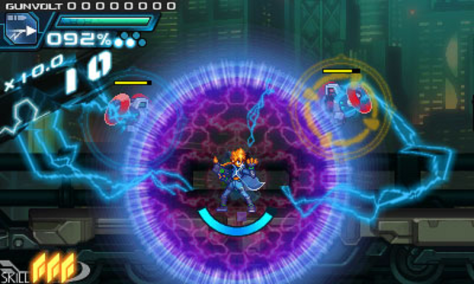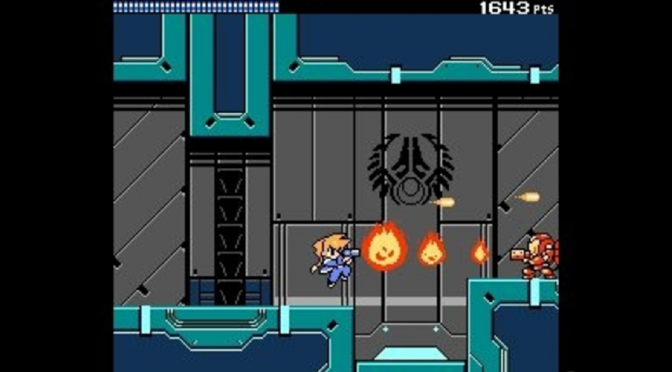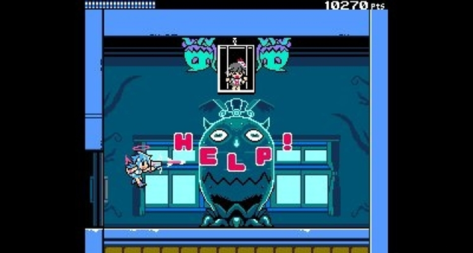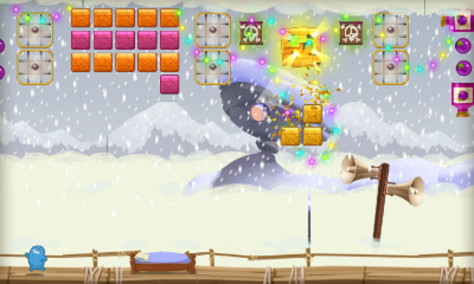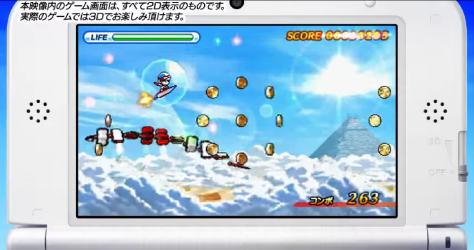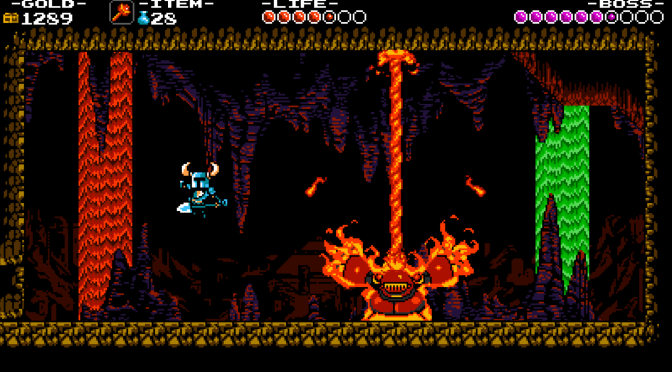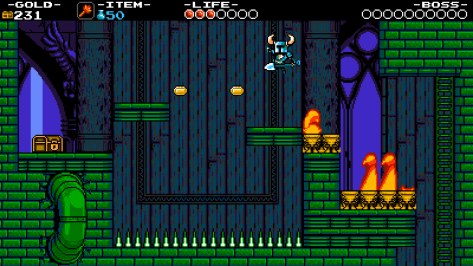Not nearly content to be making just one ‘retro platforming game with modern design that’s heavily-inspired by Mega Man’, developers Inti Creates and Comcept decided to go ahead and build three. The most-anticipated of the bunch (and guaranteed to be the most like the Blue Bomber), Mighty No. 9, is still a ways off, but Azure Striker GUNVOLT, calling the Nintendo eShop its current home, isn’t too shabby for a hold-you-over either.
The game’s protagonist, Gunvolt (or just ‘GV’ to his close friends and co-workers), shares some traits with Capcom’s prolific mascot; he controls similarly, traverses various themed levels filled with cut-and-paste robotic adversaries, and takes on plenty of fiendish end bosses. Though the two games end up remarkably different in summation, it’s still not hard to see the inspirations.
Gunvolt is an ‘Adept’, a superhero / science experiment of sorts that’s able to wield the power of lightning.
He works for the mercenary group QUILL on a freelance basis, taking on their contracts and sheltering ‘The Muse’, a dual-personality (named Lumen / Joule) that’s wanted by the Sumeragi Corportation— world-class bad guys— as a means to control the planet’s other adepts, and therefore, the planet itself. The story isn’t mind-blowing by any stretch, but features enough bits and twists to keep you moving forward. Said Sumeragi Corporation provides your assortment of baddies, which leads into combat and breaks with Mega Man‘s traditional form of fighting. This is one of Azure Striker GUNVOLT‘s defining mechanics.
While your pistol can defeat foes on its own, it will be a painful, time-consuming process. Rather, the game wants you to ‘tag’ targets with your gun, then destroy them with your ‘flashfield’, an electrified attack that shoots bolts of lightning at any marked enemies. This essentially allows you to ‘combo’ targets and clear rooms quickly, tagging them multiple times for even more damage and keeping the pace (and style) up. It’s effective and satisfying, adding a nice layer of depth on top of the core shooter mechanic that everyone’s accustomed to. You level up via combat, all RPG-like, adding to Gunvolt’s health and ‘supermove’1 set. Crafting is also introduced here, allowing you to build accessories to equip to every part of your body. These can range from additional weapon effectiveness to double / triple jumps, or let you take more damage, say, for increased Kudos (ASG‘s in-game scoring).
The way you tackle stages has been slightly tweaked as well. You’re still allowed to visit most in any order you choose (required ‘story’ missions will sometimes interject), but this freedom to pick is intentional. as you’ll likely have to revisit these stages many times, in order to acquire more components to craft parts, or to complete ‘challenges’— one-off tasks specific to each stage, that award you with even more rare components. It’s the typical ‘carrot on a stick’ type of reward system, handing out its goodies slowly. You don’t actually need any of these upgrades / boosts to complete the game, but they will certainly make your life easier.
That kind of grinding naturally gets repetitive, as do the slightly-mudane level layouts. It’s a good thing the boss fights in ASG are a highlight, showing off the developer’s stellar creative design and the game’s personality. Every Adept that the Sumeragi throws at you has his or her own style and way of attack, requiring patience and a strategic trade-off with your flashfield. These fights go through three stages of metamorphosis, adding a new pattern or higher-damage move to your rival’s repertoire each round. It can be challenging.
Azure Striker GUNVOLT is the slickest kind of 16-bit, impressing you with its fresh ideas, while simultaneously frustrating you with some old tricks.
The same can’t be said of the difficulty elsewhere. For all its polish, Azure Striker GUNVOLT is the slickest kind of 16-bit, impressing you with its fresh ideas, while simultaneously frustrating you with some old tricks. Outside of the boss battles, which will test your mettle, it’s really easy to win. Part of this is due to the flashfield. So long as you have electric energy to spare, Gunvolt won’t lose health when hit. Your combo meter will take a dive, but you’re otherwise unscathed, taking away some of the threat and immediacy in each and any battle. Worse (or easier) still, The Muse will occasionally resurrect you when you do die, turning you into a nigh-invisible God. Then there’s the reused enemies, miniboss tanks / mechs2… even its clever bosses aren’t sacred. Like Shovel Knight, another modern / retro platformer, ASG parades some of its more colorful Adepts out for a second fight near the end, forcing to you fight them back to back to back. Much like that aforementioned game, it doesn’t work here either, and feels forced.
Thankfully, these sour points are mitigated by the inventive side of the combat, the otherwise excellent character design, and its tiny 8-bit brother. Azure Striker GUNVOLT still gets a lot right, and it’s (almost) everything you could ask for from a modern platformer. At least until Mighty No. 9 comes out, fingers crossed.

